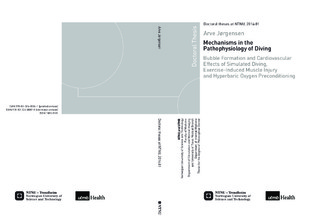| dc.contributor.author | Arve, Jørgensen | nb_NO |
| dc.date.accessioned | 2014-12-19T14:24:11Z | |
| dc.date.available | 2014-12-19T14:24:11Z | |
| dc.date.created | 2014-03-05 | nb_NO |
| dc.date.issued | 2014 | nb_NO |
| dc.identifier | 703289 | nb_NO |
| dc.identifier.isbn | 978-82-326-0086-1 (printed version) | nb_NO |
| dc.identifier.isbn | 978-82-326-0087-8 (electronic version) | nb_NO |
| dc.identifier.uri | http://hdl.handle.net/11250/264880 | |
| dc.description.abstract | Currently, there are millions of recreational divers and underwater workers worldwide. Although humans cannot live naturally underwater, certain physiological mechanisms can adapt the human body so that it may explore the underwater environment. During diving, increased pressure surrounding the body leads to high levels of different breathing gasses, for example nitrogen (N2) and oxygen (O2). During a dive, N2 accumulates in the tissues. On ascent to the surface, the ambient pressure decreases (decompression) and bubbles may form due to excess N2. The general opinion is that these gas bubbles are the cause of the clinical manifestations termed decompression sickness (DCS), which is a major health risk to divers. However, even when dives are performed in compliance with today’s procedures, which are commonly accepted as safe, bubble formation and DCS still occur. Despite many years of study, there is still limited knowledge of the mechanisms by which bubbles form and how they are involved in DCS development. Previous studies have shown that physical exercise and exposure to increased levels of O2 in the breathing gas may have a significant impact, in both reducing and increasing bubble formation and DCS risk. It is believed that exercise-induced muscle injury may enhance bubble formation and that high levels of O2 during diving may enhance DCS risk. In contrast, exposure to high O2 levels prior to diving may reduce DCS risk. However, little is known about the mechanisms behind these observations.
In the present study, we investigated whether physical exercise may lead to enhanced vascular bubble formation (paper I), how diving-induced bubbles may initiate DCS (paper II and III), and how exposures to high levels of O2 in the breathing gas may increase or reduce injury from diving (paper II and III). To simulate diving, rats were exposed to a high ambient pressure in a hyperbaric chamber, then a rapid pressure reduction to induce bubble formation. Immediately after the dive, the rats were anesthetized and the amount of vascular bubbles was evaluated by ultrasonic imaging. Blood and tissues were collected and analyzed. The first findings were that eccentric exercise-induced skeletal muscle injury made prior to diving did not seem to affect vascular bubble formation (paper I). Thus, our results do not endorse a link between exercise-induced muscle injury and vascular bubble formation. Analysis of the effects of diving on the early genetic responses in vascular tissue after diving, using full genome gene expression profiling (paper II), found that high levels of O2 in the breathing gas are likely to be an important contributor in DCS etiology. In addition, it was noted that enhanced coagulation and inflammation may be involved in DCS development. Finally, we found that high bubble loads after diving led to elevated cardiac stressmarker levels (paper III). Further, it seemed that that preconditioning with hyperbaric O2 prior to diving prevented cardiac injury induced by vascular gas bubbles, which was indicated by an attenuated rise in stress-marker levels. Thus, the factors that were identified as being important in DCS development included exposure to high levels of O2 prior to and during the dive, as well as high bubble loads occurring post-dive.
The main implications of the present study are that eccentric exercise causing muscle injury prior to diving does not seem to increase vascular bubble formation after diving and that exposure to high levels of O2 during diving seem to be involved in the adverse effects of diving. However, the adverse effects may be prevented by prophylactic exposure to high O2 levels prior to the dive. Understanding how physical exercise and exposure to high levels of O2 affect the risk of bubble formation and DCS is important, as it will facilitate preventive measures to help increase the safety of divers. Furthermore, it is our hope that this study may yield new and broader insight into the mechanisms of bubble formation and the pathogenesis of DCS after diving. | nb_NO |
| dc.language | eng | nb_NO |
| dc.publisher | NTNU | nb_NO |
| dc.relation.ispartofseries | Doktoravhandlinger ved NTNU, 1503-8181; 2014:81 | nb_NO |
| dc.relation.haspart | Jørgensen, Arve; Foster, Philip P; Eftedal, Ingrid; Wisløff, Ulrik; Paulsen, Gøran; Havnes, Marianne B; Brubakk, Alf O. Exercise-induced myofibrillar disruption with sarcolemmal integrity prior to simulated diving has no effect on vascular bubble formation in rats.. European Journal of Applied Physiology. (ISSN 1439-6319). 113(5): 1189-98, 2013. <a href='http://dx.doi.org/10.1007/s00421-012-2537-z'>10.1007/s00421-012-2537-z</a>. <a href='http://www.ncbi.nlm.nih.gov/pubmed/23129090'>23129090</a>. | nb_NO |
| dc.relation.haspart | Eftedal, Ingrid; Jørgensen, Arve; Røsbjørgen, Ragnhild; Flatberg, Arnar; Brubakk, Alf O. Early genetic responses in rat vascular tissue after simulated diving.. Physiological Genomics. (ISSN 1094-8341). 44(24): 1201-7, 2012. <a href='http://dx.doi.org/10.1152/physiolgenomics.00073.2012'>10.1152/physiolgenomics.00073.2012</a>. <a href='http://www.ncbi.nlm.nih.gov/pubmed/23132759'>23132759</a>. | nb_NO |
| dc.relation.haspart | Jørgensen, Arve; Foster, Philip P; Brubakk, Alf O; Eftedal, Ingrid. Effects of hyperbaric oxygen preconditioning on cardiac stress markers after simulated diving.. Physiological reports. (ISSN 2051-817X). 1(6): e00169, 2013. <a href='http://dx.doi.org/10.1002/phy2.169'>10.1002/phy2.169</a>. <a href='http://www.ncbi.nlm.nih.gov/pubmed/24400168'>24400168</a>. | nb_NO |
| dc.title | Mechanisms in the Pathophysiology of Diving: Bubble Formation and Cardiovascular Effects of Simulated Diving, Exercise-Induced Muscle Injury and Hyperbaric Oxygen Preconditioning | nb_NO |
| dc.type | Doctoral thesis | nb_NO |
| dc.contributor.department | Norges teknisk-naturvitenskapelige universitet, Det medisinske fakultet, Institutt for sirkulasjon og bildediagnostikk | nb_NO |
| dc.description.degree | PhD i medisinsk teknologi | nb_NO |
| dc.description.degree | PhD in Medical Technology | en_GB |

